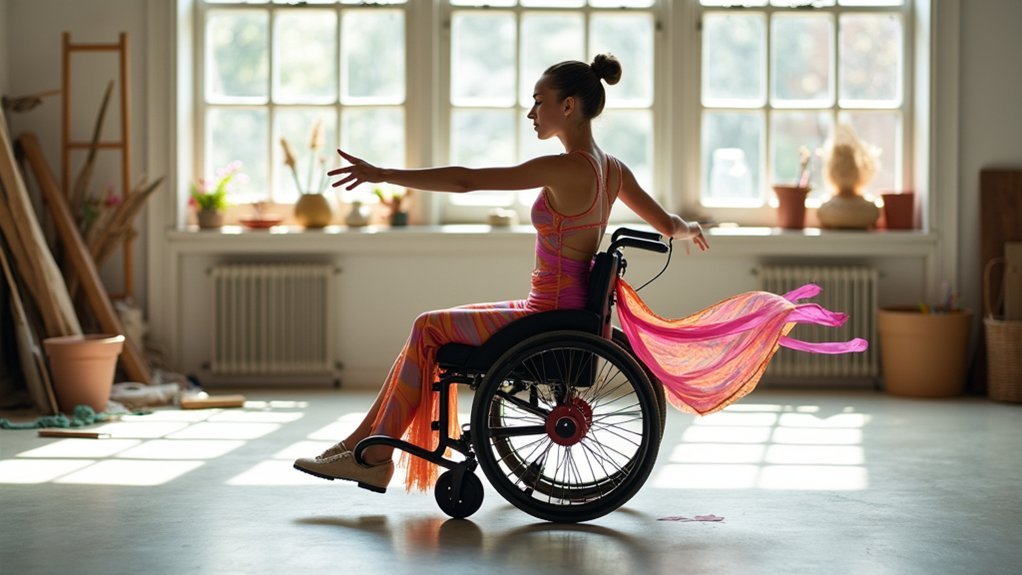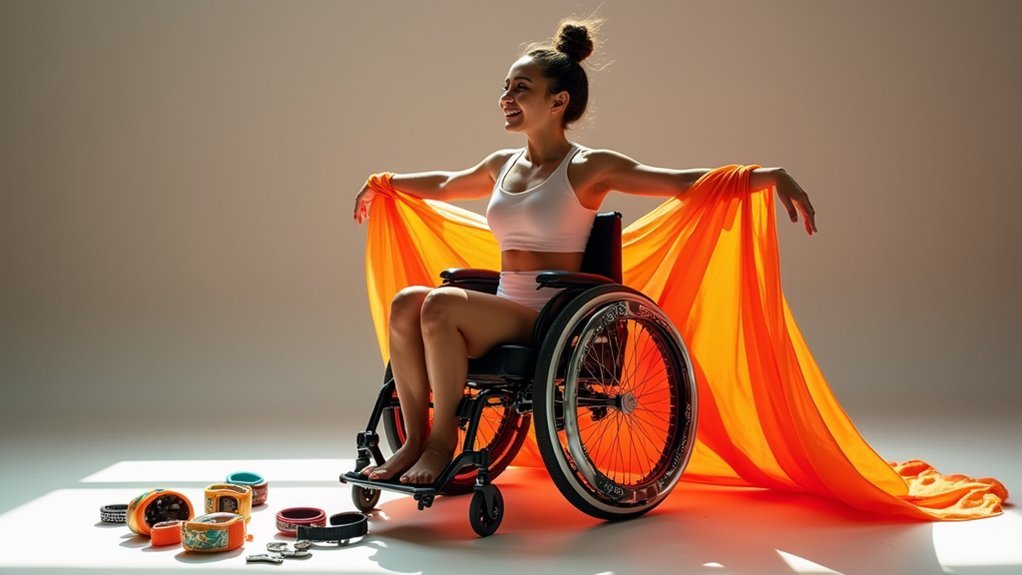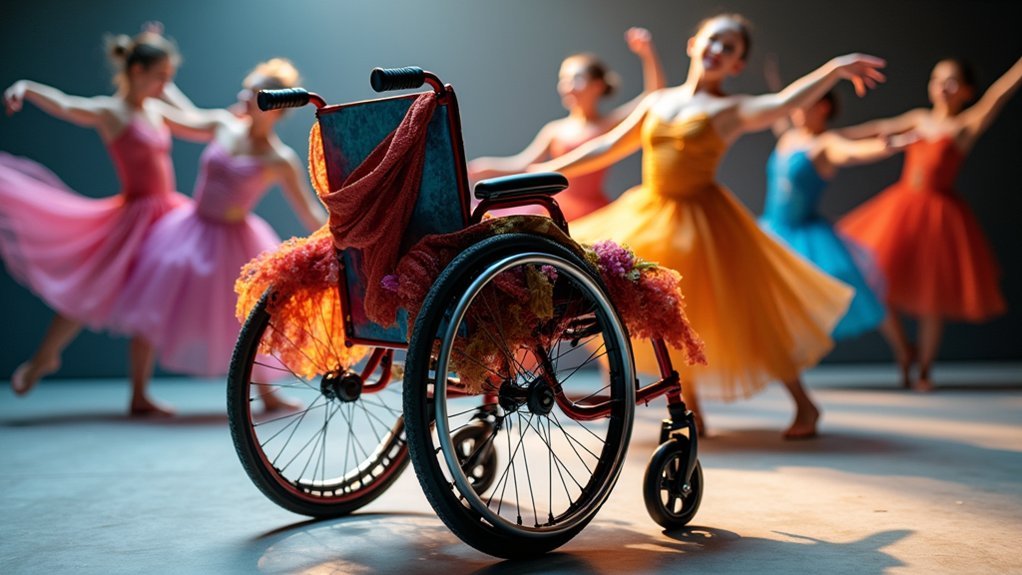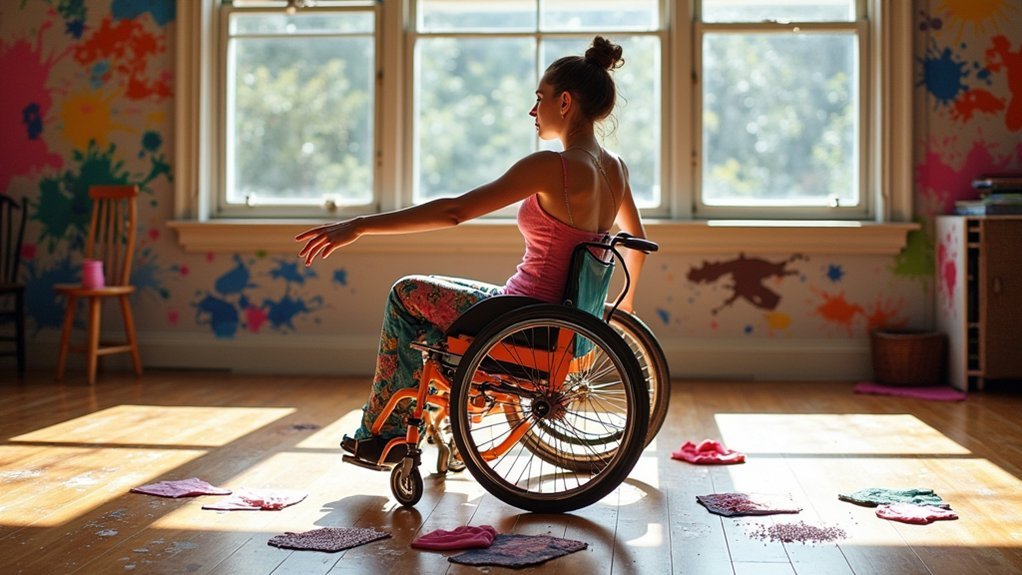Customizing dance gear for wheelchair users elevates artistic expression through adaptable equipment that enhances movement. You’ll benefit from performance-optimized wheelchairs with omnidirectional capabilities, independently rotating seats, and height adjustment features. Pair these with stretchable attire and modular accessories designed specifically for seated performances. Smart technology integration allows hands-free control through mobile devices or body movements. Discover how these personalized adaptations can transform traditional dance movements into unique expressive vocabularies that bridge human connections.
Innovative Wheelchair Design Features for Dancers

When traditional mobility equipment meets artistic expression, innovation thrives in the form of dance-specific wheelchairs.
You’ll find these specialized chairs offer omnidirectional movement capabilities that let wheelchair dancers glide seamlessly in multiple directions, transforming conventional limitations into artistic opportunities.
The magic continues with independently rotating seating systems that separate from the base, allowing you to execute complex turns and changes without repositioning your entire chair.
Experience freedom in motion with seating that spins independently from the base, revolutionizing turns without moving your entire wheelchair.
You can adjust your height to maintain eye contact with standing partners, creating more inclusive performances.
Many designs now feature mobile device controls, giving you hands-free operation as you dance.
Some advanced models even respond to your body’s natural movements—translating a simple lean or twist into synchronized motion, creating more intuitive and expressive performances.
Translating Traditional Dance Movements for Seated Performance
With specialized wheelchairs as your foundation, you’re ready to transform classical dance vocabulary into seated expressions. Your arms become powerful tools—extend them outward for a “brush” movement instead of using legs.
When traditional dancers turn by marching in circles, you’ll create the same visual effect by rotating your wheelchair with precision.
Want to capture the excitement of jumps? Perform controlled wheelies to express that upward energy while maintaining rhythm within the standard four-count structure. These adaptations guarantee you can dance together with standing performers in perfect synchronization.
Don’t limit yourself to established translations—experiment with creative interpretations of traditional movements. By exploring new possibilities for seated choreography, you’ll expand the dance vocabulary for everyone and enrich the artistic landscape of inclusive performance.
Personalized Gear Adaptations That Enhance Expression

Choosing the right equipment transforms your ability to express yourself through wheelchair dance. Customizing your gear creates a seamless extension of your artistic vision, allowing movements that might otherwise be constrained.
- Adaptive security systems – Invest in adjustable harnesses and seat belts that provide stability while maintaining freedom for expressive movement, creating the perfect balance between safety and artistic liberty.
- Performance-optimized wheelchairs – Consider omnidirectional models that enable fluid, multidimensional movement patterns, expanding your choreographic possibilities.
- Tailored attire solutions – Select stretchable, lightweight fabrics specifically cut for seated performance that won’t restrict your range of motion or create unnecessary bulk.
Remember that modular accessories can be swapped for different dance styles, making your customized gear versatile across various performance contexts.
Building Empathetic Connections Through Adaptive Equipment
Dance transcends physical limitations when your adaptive equipment becomes a bridge rather than a barrier to human connection. Innovative wheelchair designs with omnidirectional movement and independent seat rotation allow you to express yourself fully while connecting with fellow dancers.
Empathy in dance flourishes through technology that enables non-physical engagement, including remote-controlled wheelchair movements that facilitate emotional connectivity despite physical differences.
You’ll discover how adaptive equipment encourages physical connection—allowing you to hold hands while moving together, strengthening bonds during performances.
With advanced adaptive technology, you’re free to engage in expressive movements that showcase your creativity and enhance the aesthetic experience.
These tools don’t just support physical expression; they emphasize the joy of movement and create deeper emotional connections between dancers, regardless of ability.
The Evolution of Physically Integrated Dance Technology

As technology advances at a rapid pace, physically integrated dance has transformed from a niche art form into a dynamic, accessible movement experience for wheelchair users.
Even though traditional wheelchairs limited movement possibilities, today’s innovative designs empower dancers with unprecedented freedom.
Traditional wheelchairs once constrained artistic expression, but today’s innovative designs unleash dancers’ creative potential with unprecedented freedom of movement.
Modern dance wheelchairs now feature:
- Omnidirectional movement systems that enable fluid motion in any direction
- Independently rotating seats that facilitate eye-level interaction with standing dancers
- Mobile device control systems allowing hands-free operation during performances
You’ll find these technological advancements creating empathetic connections between performers by enabling shared movement experiences.
The integration of smart technology with wheelchair design continues to break barriers, allowing dancers with disabilities to express themselves more fully through movement.
Your dance potential expands as these adaptive technologies evolve.
Frequently Asked Questions
How Do Dancers Show Expression When They Dance?
You express emotions through your body movements, facial expressions, and rhythm. You convey stories by synchronizing with music, utilizing space creatively, and connecting with your audience through the dynamic energy of your performance.
What Is the Dance Troupe for Disabled People?
The Dance Troupe for Disabled People, like Dancing Wheels Company, is an inclusive performance group you’ll appreciate for integrating dancers with and without disabilities. It’s founded by Mary Verdi-Fletcher and promotes accessibility in dance.
What Are the Words for Dynamics in Dance?
In dance dynamics, you’ll use words like sharp, smooth, explosive, sustained, heavy, light, flowing, staccato, soft, strong, sudden, swing, suspended, percussive, collapse, vibrate, bound, free, direct, and indirect to describe movement qualities.
How Do Wheelchair Users Dance?
You dance by adapting traditional moves, using your wheelchair as an extension of your body. You’ll spin, glide, and extend your arms gracefully. You can perform with standing dancers in physically integrated performances.
In Summary
When you customize your dance gear and wheelchair for performance, you’re not just adapting equipment—you’re expanding dance itself. You’re challenging perceptions while creating new movement possibilities that bridge physical differences. As technology and design continue to evolve, you’ll find even more ways to express your unique artistic voice. Your innovations don’t just benefit you—they’re reshaping dance for everyone.





Leave a Reply